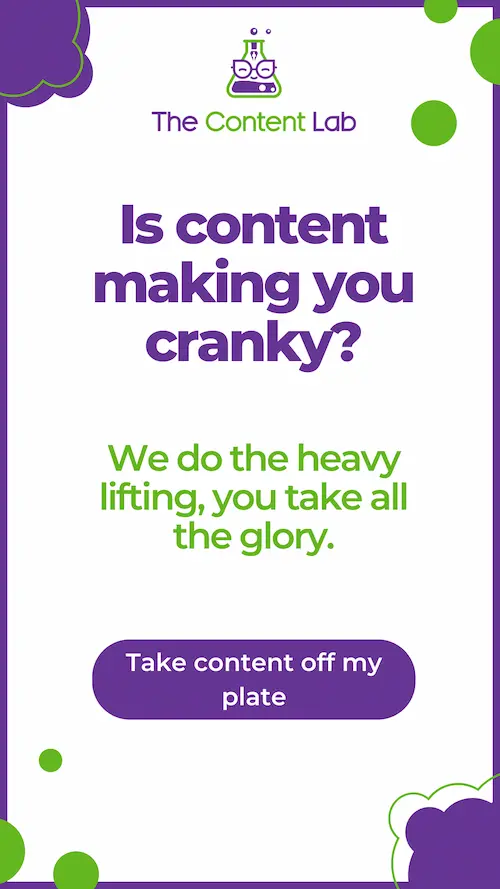The year is 2025. Nobody writes anything for themselves anymore. Not even letters to their loved ones. Joaquin Phoenix is in love with an operating system with a surprisingly sultry lilt in her voice (even though she can’t fully appreciate his rockin’ mustache, what with being an intangible entity and all.)
Hang on… Is that the plot to Spike Jonze’s film ‘Her’, or do I need to take a lie down?
Regardless, this work of fiction is pretty on the nose in its prediction of the reality we’ve found ourselves in today.
It’s true, less and less people are writing content for themselves. And no, I’m not referring to outsourcing content writing to a professional copywriter, which is generally a good idea – I’m not biased at all! We’re talking about people using AI to write everything for them, from blogs to breakup texts.
Does AI have a place in content creation?
AI tools have been around for quite some time now. But particularly since the world-wide launch of AI tools like ChatGPT, artificial intelligence seems to be all anyone can talk about in the digital agency industry. Especially when it comes to content creation.
Am I thrilled about the increase in AI-generated content being produced en masse and pumped out online at an unholy rate?
Nope. And you shouldn’t be either.
Here’s why:
- AI misses the mark: AI-written content doesn’t speak to your target audience.
- Snore-ville: AI struggles to convey any kind of creativity, character, or originality in its writing.
- AI produces unreliable info: You can’t trust that all information gathered by AI is accurate. As it begins consuming other AI-produced information, it’s highly likely that the quality (and reliability) of future AI output will diminish rapidly.
- It lacks nuance: AI can’t understand context, subtlety, or humor the way a human writer can.
- Unedited AI text hurts SEO: Using AI-written, unedited text can weaken your website’s ranking.
- Damages credibility: Ultimately, AI-written copy can damage your agency’s reputation by taking away that human connection.
Phew! That’s a whole lot of reasons to think twice before jumping on the AI content train, isn’t it?
Now listen, of course AI has its uses in assisting content creation. My copywriting team even use it to help us with certain parts of the content creation process, like:
- Coming up with ideas for blog titles
- Giving a rough guide for blog outlines
- Spellcheck and grammar checks
- Explaining difficult subject matters
Let it be clear, though, that we never ever use AI to create content of any kind. And we never will!
AI content detectors: Useful tools or simply adding more AI to an already AI-filled situation?
The internet has become the Wild West of AI-generated content. So much so that it’s now estimated that a scary 11.5% of Google’s highest rated content has been created by AI.
You already know that content created by AI can’t be fully relied on, (just think of all the scams and fake images doing serious damage in the real world), raising the question of what content we can and can’t trust online. That’s why being able to detect AI-generated text online is so important.
However, this increase in content generated by machines is making it all the more difficult to accurately detect it when it inevitably makes its way onto our screens.
That’s where AI detector tools can come in handy.
Let me set the scene. You’re scrolling the internet searching for a brand new life coach who’s going to help you overcome your obstacles and get on track so you can fulfill your dreams of opening a goat and geese sanctuary on a remote island. (Just me?)
Their website looks good – plenty of cute animal images on there which is always a winner! But something seems a little… off.
You decide to test the results in an AI content detector and it confirms your suspicions, the entire website has been written by AI. Does the life coach even exist? How trustworthy is the person behind this website to share your struggles and issues with?
Sure, using an AI writing detector can be super useful in helping you detect AI-generated text online. But can we really rely on them to accurately tell the difference between AI-written and human-written text?
The research suggests not entirely. That’s because AI detectors can sometimes give false positives and can even be undermined.
Here’s how:
- AI detectors can mistake human-generated content for AI – especially content written by non-native English speakers.
- As well as giving false positives, sometimes AI detectors fail to identify AI-generated content and pass it as human writing.
- AI detectors can flag SEO optimization as AI-written content, as opposed to AI-assisted.
- AI writing tools are learning the triggers for these detectors and are actively trying to overcome them.
When you’re already questioning what content you can and can’t trust online, it’s a good idea to wonder about the reliability of online AI tools, too – even if they are designed to detect AI content!
Sometimes, it’s best to rely on yourself instead of passing the responsibility onto another AI tool once again.
How to spot AI-generated text yourself
Have your eyes turned into two cartoon swirls from trying to identify AI-generated content online? ????????
Don’t worry, we’ve got you.
While spotting AI-generated images often doesn’t require too much effort (hello 7 fingers on a hand), recognizing AI-written text can sometimes be a little trickier for the average internet user – which is what makes it so dangerous!
As a professional writer, I’ve got a pretty keen eye when it comes to differentiating AI text from human text. I’m acutely in tune with the natural ebbs and flows of human-written content, so when we’re reading something written by AI, I always know it. Call me the AI sniffer dog of the digital world, if you will.
While I’ve acquired these skills over many years in the industry, there are certain things you can keep an eye out to help you detect AI content more easily, too.
So, without further ado, here are my top tips to help you spot AI-generated text online yourself without needing to use an AI-detection tool!
1. Keep an eye out for repetitive language
Have you ever read a piece of content online and noticed the same words popping up time and time and time and time again?
Ok, maybe it’s not always going to be quite so obvious as that! But when you pay attention, it can become clear pretty fast.
As we mentioned earlier, AI lacks creativity. Sorry robots, but it’s simply true. That applies to its use of language, too.
Next time you’re sifting through a piece of content online, take note of any obvious repetition of words or phrases that a human would simply not write. You’d be surprised just how much AI loves to repeat itself!
2. Watch out for odd sentences that don’t flow well
This point is probably the most glaringly obvious one when it comes to spotting AI-written content.
While AI is certainly very adept at creating content at a rate only Jim Carrey playing the role of God in Bruce Almighty is capable of, it’s not super skilled at making its content read very well.

If alarm bells start going off in your head when you’re reading content online or content that’s been sent to you by a client, it’s best not to ignore them. Odd sentences that seem disjointed or unnatural are a true teller of AI-written content, so don’t be afraid to follow that feeling and question it if something isn’t sitting quite right with you.
3. Notice sentence structure and length
As humans, we spend all day communicating with other humans. (Even if a lot of it is digitally!)
Humans will naturally vary sentence length in our writing. Whether it’s intentional or not, we all do it. From emphasizing for dramatic effect to influencing the musicality and rhythm of our writing, it’s an essential part of writing engaging text.
AI writing tools are much more one-dimensional when it comes to the flow of content. Look out for content made up of sentences that are all similar in length and structure. Odds are, you’ve caught yourself a piece of AI writing!
4. Consider how basic the content is
While keeping your language simple and to the point is the best way to connect with your audience when writing online content, that doesn’t mean the content itself needs to be simple.
Humans are well able to explore complex topics while still making written content accessible, interesting, and engaging.
AI is not yet at a point where it’s capable of tackling more in-depth themes in an approachable way or of offering any sort of unique insight or original opinion. (Not that we are complaining, because that would well and truly be scary!)
That’s to say that if content reads as a little basic or else overly-complex to the point where it doesn’t actually make sense, then the likelihood of it being written by AI is pretty high. Remember, humans are capable of nuance. Robots are not.
5. Read into tone and word choices
Lastly, tone is often a very telling sign when revealing a piece of AI-written content.
Is the tone of voice appropriate within the context of the content? Does it reflect the brand personality? Or does it quite simply read like it’s been written by a robot? Well, it probably was then!
If there’s one thing for certain that AI writing tools are very much so not capable of doing, it’s adapting to voice, tone, and language. When these are such essential elements of effective copywriting, it’s fair to say that AI has a pretty significant shortcoming if the goal is to produce quality content.
AI text generators will also choose the strangest words at times. Not in a mysterious, brooding way like that English Lit major you fancied at university. (Why.) Just in a straight-up this makes no sense way.
Pay close attention to the word choices in online content. If it doesn’t seem like something a human would say, it’s probably because they wouldn’t.
List of words and phrases to help you spot AI-generated text
AI text generators work by scanning content online, processing it, and spitting it out in the form of a somewhat “new” piece of content. While the speed at which it does this is undeniably impressive (and scary), the final results tend to leave a lot to be desired.
That’s because text created by an AI writing tool all reads the same, which as it turns out, is very helpful in helping you familiarize yourself with the AI writing style so you can catch it more easily online.
We’ve put together a list of some words and phrases that AI writing tools have a particular habit of using to help you spot AI-generated content in the future.
Words commonly used by AI writing tools:
- Embark
- Crucial
- Relentless
- Groundbreaking
- Endeavour
- Enlightening
- Unleash/Unlock
- Elevate
- Ensure
- Foster/fostering
- Moreover/furthermore
- Thus
Phrases commonly used by AI writing tools:
- Shed light
- Dive into/Delve into
- In the world of
- In today’s digital era/In today’s modern era
- Digital landscape
- Hustle and bustle
- In contrast
- As previously mentioned
- Sights unseen/Sounds unheard
- In this blog post, we will discuss…
- To begin with…
- In conclusion/In summary
- Out of the box
How many of the above were ringing a few digital-sounding bells in your head? We bet now that you’ve read them, you won’t stop seeing some of them popping up online!
When your content has been written or heavily edited by a human100% human-written, it’s guaranteed to be super engaging, incredibly insightful, and entirely unique! Not to mention optimized for search engines, too.






